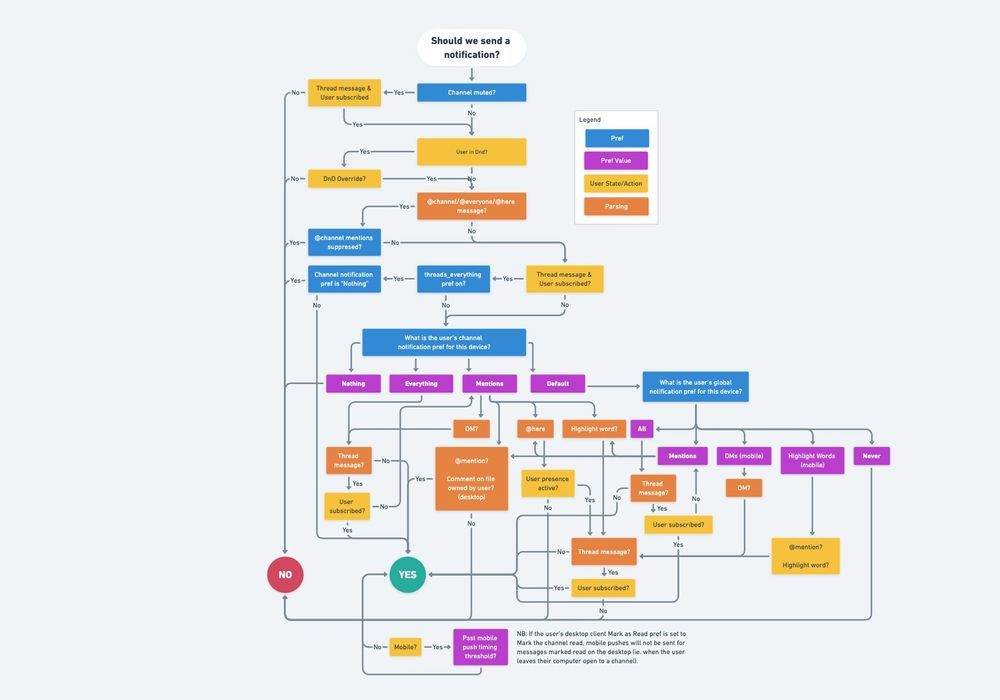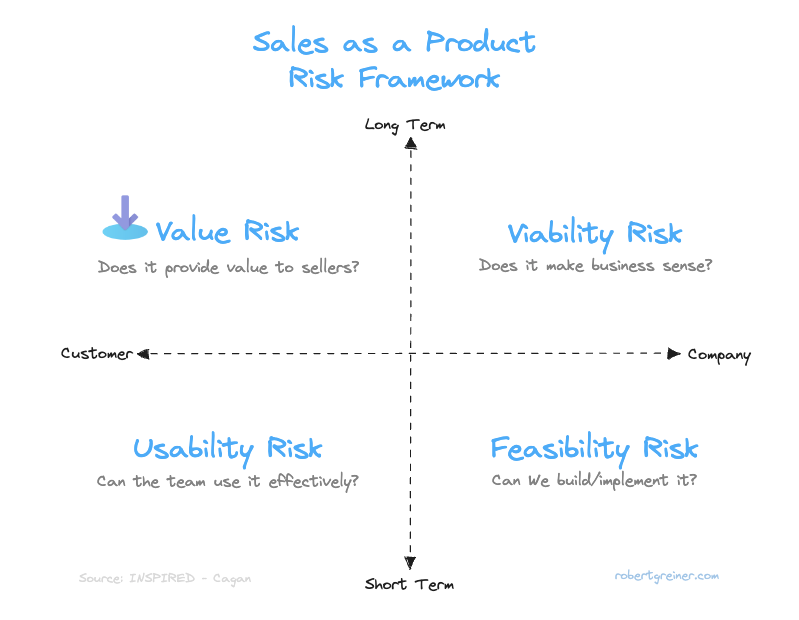Sales as a Product
The power of Product in reimagining your sales approach.

The best product teams in the world obsess over every detail - from the form factor and features to packaging and peripherals. They nitpick every microsecond, fretting over delays caused by clunky positioning or laggy interfaces. Conference rooms buzz with debates over user emotion metrics, gauging the joy or frustration experienced while shopping for a new outfit or changing a profile photo.
Does this sound like overkill to you? Check out Slack's workflow for whether or not the app sends you a notification.

Details matter. Not just in product development, but also process.
When was the last time you obsessed over your sales process with the same level of minutiae? How many dollars are you leaving on the table through confused reps, misaligned silos, and delayed deals? Does your sales process resemble the Wild West, or is it a finely tuned, repeatable machine?
While we may think we understand our external customers intimately, we often overlook our internal customers—our employees. Their experience with our sales systems directly impacts our bottom line, influencing revenue, growth, and profitability targets quarter after quarter.
To thrive as revenue leaders, adopting a product-centric mindset for our sales process isn't just useful; it's essential.
Where do we start? I'm glad you asked. Let's address the four primary product risks that can make or break your sales process.
Managing The Four Product Risks
Marty Cagan writes about the four critical product risks in his book INSPIRED aimed at helping product-centric organizations create products that customers love. These four risks offer an insightful framework for a wide range of products and processes and apply remarkably well to sales.
- Value Risk: Will the product provide value to customers?
- Usability Risk: Can users effectively use and understand the product?
- Feasibility Risk: What limitations make the product difficult to implement?
- Business Viability Risk: Does the product make business sense to build?
What's intriguing is that Cagan's framework can be applied as an analytical tool beyond the product-design space. Let's look at how to potentially overlay these four risks to the design and execution of a world-class sales process:

Value Risk: Internal Customer-Centricity
Does it provide value to our sellers?
At the crux of Marty Cagan's "Value Risk" is a deceptively simple question: Will the product provide value to customers? In the context of sales, the customers are your sales team members. They're the ones who interact most frequently with your sales process, and their experience with it is a make-or-break factor for your overall revenue.
Ensuring value for these internal customers is not just about making their lives easier but also about augmenting their capabilities. The focus here should be on eliminating friction and providing powerful tools that empower them to succeed—essentially, turning them into "super-users" of your sales process, much like how power users exploit software to its fullest extent and give them an advantage over their less savvy peers.
Mitigation Tactics:
- Voice of the Sales Team: Begin by embedding a "Voice of the Sales Team" mechanism into your process. This could be in the form of regular roundtable discussions, surveys, or even shadowing sales calls. The idea is to obtain firsthand knowledge of the hurdles that your team faces. These insights serve as the building blocks upon which to refine your sales process.
- Iterative Improvements: The most effective solutions often come from a series of small, iterative improvements rather than a single, sweeping change. Take a page from Agile methodologies and introduce rapid cycles of implementation and feedback. After each iteration, measure key performance indicators like deal-closure rates and the length of the sales cycle. Use these metrics to make data-driven adjustments, much like how a GPS reroutes you based on real-time conditions.
- Feedback Loops: Install feedback loops not just between the sales reps and their managers, but also among peers. A culture of open feedback transforms your team into a community of learners, all sharpening each other’s swords. This collective wisdom can significantly augment your sales process. Think of this as a continuously updated, collaborative effort.
- Gamification: Let's face it, our sellers are coin-operated and competitive. Creating gamified structures that create additional rewards and public recognition will create a palpable buzz around events that motivate action.
Usability Risk: Streamlined User Experience
Can the user figure out how to use it?
Usability maps directly to how intuitive and accessible your sales process is for your sales team. Suppose the workflow is difficult to navigate or too complex. In that case, you'll end up with frustrated employees who may eventually miss targets or even quit, creating a tough vacuum to fill and disrupting revenue streams.
Let's remember, that a poor user interface can be as damaging in the sales process as it is in a mobile app. Think of the Netflix interface that maximizes user engagement, with algorithms that suggest "what to watch next," guiding the user journey. That’s the level of thoughtfulness and usability we should aim to integrate into our sales processes.
Mitigation Tactics:
- User-Centric Training: Training should be more than a stale one-time PowerPoint presentation. Create bite-sized modules, combining documentation, videos, microsites, and hands-on practice sessions. Consistency is the key. Repetition not only drives understanding but also ensures that the sales process becomes muscle memory.
- Simplify and Standardize: Eliminate redundant steps and introduce templates where possible. You don't need to recreate the wheel for every proposal or email. If everyone uses the same playbook, it's easier to identify which plays are effective and which need to be removed or modified.
- On-Demand Support: Create a "Bat-Signal" for your sales team—a quick, easy way to summon help when they're stuck in a particular part of the sales process. Think of this like Apple's Genius Bar but for sales; a resource always on standby to answer questions and resolve issues, ensuring that no deal falls through due to systemic issues.
Feasibility Risk: Scale and Complexity
Can we realistically implement this?
The principle of scalability is often overlooked. No one starts training for a marathon by running 26.2 miles on day one. It's about scaling your efforts over time. The feasibility of your sales process should be looked at similarly.
Mitigation Tactics:
- Pilot Programs: Run smaller pilot programs with subsets of the team to evaluate the new processes or tools before full-scale implementation. Use metrics like "Time to First Deal," "Customer Satisfaction," and "Employee Satisfaction" to gauge the success of the pilot. Asking how likely your pilot teams are to recommend new changes to their colleague (NPS) will also give valuable insights.
- Phased Implementation: Roll out the new process or tool in phases to different departments or geographic locations, depending on your organizational structure. This ensures you don't bite off more than you can chew, making adjustments more manageable.
- Regular Audits (Hot Wash): Frequent evaluations, or "hot washes," provide the chance to review what's working and what's not, allowing for quick adjustments. These should be data-driven and involve feedback from the ground level.
- Scalability Assessment: Make it a point to evaluate the process for scalability periodically. As your team grows, the process should be able to adapt without becoming a bottleneck.
Business Viability Risk: Return on Investment
Can we afford it?
Your sales process should be looked at as an investment. Like any investment, you expect a return. The risk here lies in how aligned your investment in the sales process is with the overall business strategy and objectives.
Mitigation Tactics:
- Cost-Benefit Analysis: Take into account not just the monetary investment but also the time, labor, and opportunity costs involved. Compare these against the expected increase in sales efficiency and revenue. Decisions should be made with a positive expected return.
- KPIs: Establish clear KPIs to measure the success of the new sales process. These could range from lead conversion rates to customer lifetime value or net promoter scores. Incorporate these trends into regular strategic discussions.
- Feedback to Strategy: Constantly channel what you've learned back into business strategy. If a particular product or service is consistently tough to sell, that's not just a sales issue; it's a product issue, and maybe even a market issue.
A disjointed sales process not only burns out your team but also has a cascading effect on revenue and company morale. As sales leaders, we must fight this entropy daily. The return on investment for "sweating the small stuff" is massive. Small improvements to your sales process through a product-oriented mindset can send positive ripple effects across the organization.
Think of your sales process as a "product" that your internal customers use daily. The user experience has to be impeccable. Addressing the four product risks—Value, Usability, Feasibility, and Viability—creates a strategic roadmap for the perpetual refinement of your sales process, impacting not just sales but the entire organization.
How did you like this article? Your feedback helps me create better content.
Thanks for reading.
Subscribe for Free
Want to stay ahead of the curve? Subscribe now to receive the latest updates, actionable insights, and thought-provoking ideas around business, technology, and leadership straight to your inbox.



